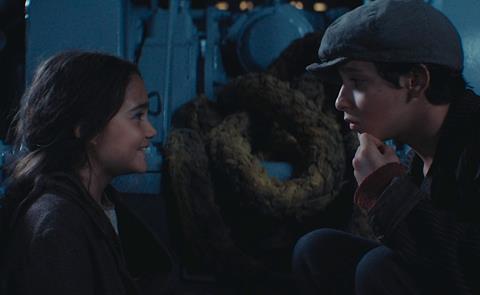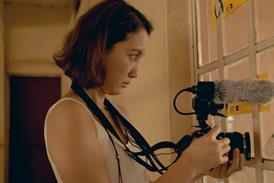Benign post-war drama from Gabriele Salvatores is based on an early Fellini treatment

Dir. Gabriele Salvatores. Italy. 2024. 122mins
Gabriele Salvatores’s Napoli–New York is based on an early script treatment by Federico Fellini, but there’s little here that you’d consider ‘Felliniesque’ – if you take that to mean dream-like, febrile, infused with the grotesque. This good-natured yarn about two Italian child child stowaways to New York has no shortage of exuberance, but overall this is a mild exercise in period picaresque that lacks a sophisticated edge. Still, the film made a very healthy late November domestic debut before heading to the Red Sea Festival; looking ahead, characterful young leads, a jovial performance from Italian star Pierfrancesco Favino, and Salvatores’s own auteur rep are its best bets for hooking audiences.
A mild exercise in period picaresque
Writer-director Salvatores – also currently artistic director of the Milan Film Festival – achieved his great moment of international glory with an international Oscar for 1991’s Mediterraneo, then scored art-house/mainstream crossover success with the 2003 adaptation I’m Not Scared. Since then, his cachet has mainly been restricted to Italy.
His script here is based on a treatment dating back to the mid-40s – discovered in 2006 and subsequently published – co-written by Fellini and Tullio Pinelli, his long-term collaborator on greats including La Strada and La Dolce Vita. The story is in three parts, with bookending episodes in Italy and the US and an ocean voyage in between. It begins in Naples in 1949, where a bomb left over from the war leaves 10-year-old orphan Celestina (Dea Lanzaro) alone and wandering the streets. She teams up with an older boy, streetwise Carmine (Antonio Guerra), whose wheeling and dealing includes an arrangement with an American ship’s cook (Omar Benson Miller) to sell a jaguar cub. That scam results in the children finding themselves on board the ship as it sails, leaving them unwitting stowaways to New York.
An ocean-bound middle section sees the duo dodging the vessel’s boozy captain (Tomas Araña) and gruff but kindly purser Garofalo (Favino). The children also discover the truth of transatlantic travel: pampered rich up above, impoverished Italian emigrants shuttered below in squalor. This haves/have-nots commentary is couched – thanks to Rita Rabassini’s plush production design – in glossily retro mode somewhere between Titanic and Spanish chic-pulp TV series High Seas.
When the children arrive in New York – where Celestina mistakes the Statue of Liberty for the Madonna of Pompeii – the film moves into a different register, and an altogether less plausible one. This Manhattan has a bizarre theme-park feel, every available wall plastered with retro-kitsch posters advertising Happiness and the American Way, with a multitude of extras kitted out as if for a 40s-styled music video. Setting out to locate Celestina’s older sister (Anna Lucia Pierro), the kids find their way to Little Italy, where they find a welcoming berth with Garafalo and his wife (Anna Ammirati); then the film morphs again, this time into a courtroom drama.
There’s a degree of dark realism at work, notably in the images of a ravaged Naples, in the shipboard depiction of social misery and class difference, and in a sinister close-up (the one authentically Felliniesque moment) that suggests Celestina narrowly escaping the peril of child prostitution. Otherwise, this tale of plucky innocents at large is all too cosily benign.
The cast is uneven but generally engaging – despite a bizarre range of more or less plausible American accents in the sporadic English dialogue – with Favino bullishly genial and Antonio Catania cheerfully guzzling the décor as a manic newsman. The kids are certainly terrific discoveries – young Lanzaro making Celestina both feisty and somewhat cranky, while Guerra gives his all to the sketchy role of a tyro tough nut, to especially winning effect in his defiant face-offs with Favino.
But the three chapters never quite gel into a whole, and the New York section especially takes some swallowing – not least in such details as a crowd of women demonstrating with banners emblazoned with ‘Women’s Liberation’ (a term already extant but not really in currency until the 60s). Similar anachronisms fill the soundtrack, which is less of a sin – although it’s a leap to use the Ronettes’ ‘Be My Baby’ to signify the spirit of 1949 Manhattan when the song could hardly scream 1963 any more definitively. (Plus points, though, for a rare screen use of Procol Harum’s grandiose gem ‘A Salty Dog’.)
Production companies: Paco Cinematografica, RAI Cinema
International sales: Paco Cinematografica info@pacocinematographica.it
Producers: Isabella Cocuzza, Arturo Paglia
Screenplay: Gabriele Salvatores, based on an original story by Federico Fellini, Tullio Pinelli
Cinematography: Diego Indraccolo
Editor: Julien Panzarasa
Production design: Rita Rabassini
Music: Federico de Robertis
Main cast: Pierfrancesco Favino, Dea Lanzaro, Antonio Guerra, Omar Benson Miller
























